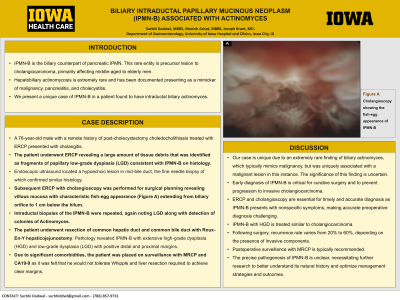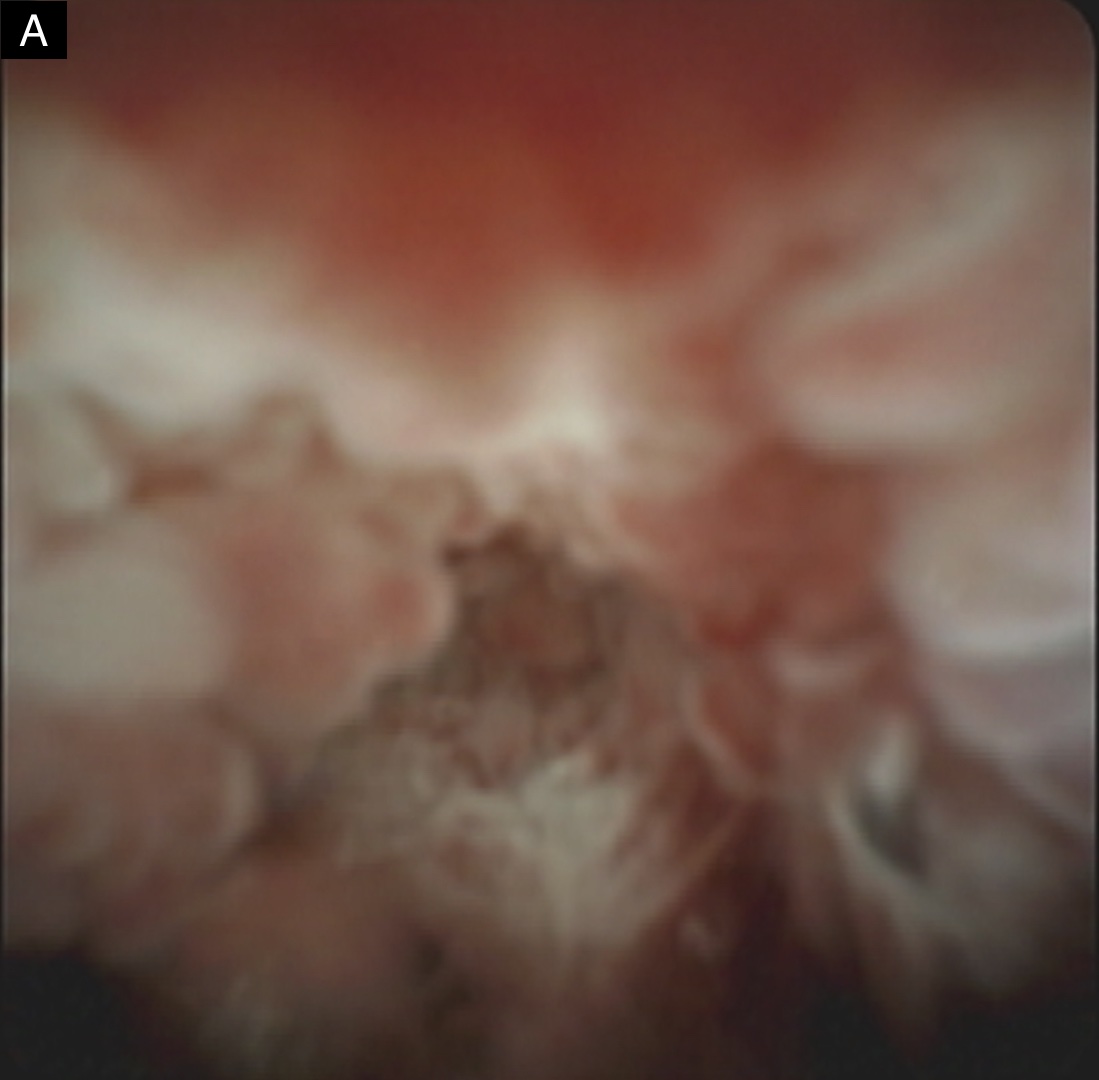Sunday Poster Session
Category: Biliary/Pancreas
P0165 - Biliary Intraductal Papillary Mucinous Neoplasm (IPMN-B) Associated With Actinomyces
Sunday, October 27, 2024
3:30 PM - 7:00 PM ET
Location: Exhibit Hall E

Has Audio

Surbhi Dadwal, MBBS
University of Iowa Hospitals & Clinics
Iowa City, IA
Presenting Author(s)
Munish Ashat, MBBS1, Joseph Brant, MD2, Surbhi Dadwal, MBBS1
1University of Iowa Hospitals & Clinics, Iowa City, IA; 2University of Iowa Hospitals & Clinics, North Liberty, IA
Introduction: IPMN-B is the biliary counterpart of pancreatic IPMN. This rare entity is precursor lesion to cholangiocarcinoma, primarily affecting middle-aged to elderly men. Hepatobiliary actinomycosis is extremely rare and has been documented presenting as a mimicker of malignancy, pancreatitis, and cholecystitis. We present a unique case of IPMN-B in a patient found to have intraductal biliary actinomyces.
Case Description/Methods: A 76-year-old male with a remote history of post-cholecystectomy choledocholithiasis treated with ERCP presented with cholangitis. The patient underwent ERCP revealing a large amount tissue debris that was identified as fragments of papillary low-grade dysplasia (LGD) consistent with IPMN-B on histology. Endoscopic ultrasound located a hypoechoic lesion in mid-bile duct, with a fine needle biopsy confirming similar histology. Subsequent ERCP with cholangioscopy was performed for surgical planning revealing villous mucosa with characteristic fish-egg appearance (Figure A) extending from biliary orifice to 1 cm below the hilum. Intraductal biopsies of the IPMN-B were repeated, again noting LGD along with detection of colonies of Actinomyces. The patient underwent resection of common hepatic duct and common bile duct with Roux-En-Y hepaticojejunostomy. Pathology revealed IPMN-B with extensive high-grade dysplasia (HGD) and LGD with positive distal and proximal margins. Due to sigificant comorbidities, the patient was placed on surveillance with MRCP and CA19-19 as it was felt that he would not tolerate Whipple and liver resection required to achieve clear margins.
Discussion: Our case is unique due to an extremely rare finding of biliary actinomyces, which typically mimics malignancy, but was uniquely associated with a malignant lesion in this instance. The significance of this finding is uncertain. IPMN-B presents with nonspecific symptoms, making accurate preoperative diagnosis challenging. Early diagnosis of IPMN-B is critical for curative surgery and to prevent progression to invasive cholangiocarcinoma. ERCP and cholangioscopy are essential for timely and accurate diagnosis. IPMN-B with HGD is treated similar to cholangiocarcinoma. Following surgery, recurrence rate varies from 20% to 60%, depending on the presence of invasive components. Postoperative surveillance with MRCP is typically recommended. The precise pathogenesis of IPMN-B is unclear, necessitating further research to better understand its natural history and optimize management strategies and outcomes.

Disclosures:
Munish Ashat, MBBS1, Joseph Brant, MD2, Surbhi Dadwal, MBBS1. P0165 - Biliary Intraductal Papillary Mucinous Neoplasm (IPMN-B) Associated With Actinomyces, ACG 2024 Annual Scientific Meeting Abstracts. Philadelphia, PA: American College of Gastroenterology.
1University of Iowa Hospitals & Clinics, Iowa City, IA; 2University of Iowa Hospitals & Clinics, North Liberty, IA
Introduction: IPMN-B is the biliary counterpart of pancreatic IPMN. This rare entity is precursor lesion to cholangiocarcinoma, primarily affecting middle-aged to elderly men. Hepatobiliary actinomycosis is extremely rare and has been documented presenting as a mimicker of malignancy, pancreatitis, and cholecystitis. We present a unique case of IPMN-B in a patient found to have intraductal biliary actinomyces.
Case Description/Methods: A 76-year-old male with a remote history of post-cholecystectomy choledocholithiasis treated with ERCP presented with cholangitis. The patient underwent ERCP revealing a large amount tissue debris that was identified as fragments of papillary low-grade dysplasia (LGD) consistent with IPMN-B on histology. Endoscopic ultrasound located a hypoechoic lesion in mid-bile duct, with a fine needle biopsy confirming similar histology. Subsequent ERCP with cholangioscopy was performed for surgical planning revealing villous mucosa with characteristic fish-egg appearance (Figure A) extending from biliary orifice to 1 cm below the hilum. Intraductal biopsies of the IPMN-B were repeated, again noting LGD along with detection of colonies of Actinomyces. The patient underwent resection of common hepatic duct and common bile duct with Roux-En-Y hepaticojejunostomy. Pathology revealed IPMN-B with extensive high-grade dysplasia (HGD) and LGD with positive distal and proximal margins. Due to sigificant comorbidities, the patient was placed on surveillance with MRCP and CA19-19 as it was felt that he would not tolerate Whipple and liver resection required to achieve clear margins.
Discussion: Our case is unique due to an extremely rare finding of biliary actinomyces, which typically mimics malignancy, but was uniquely associated with a malignant lesion in this instance. The significance of this finding is uncertain. IPMN-B presents with nonspecific symptoms, making accurate preoperative diagnosis challenging. Early diagnosis of IPMN-B is critical for curative surgery and to prevent progression to invasive cholangiocarcinoma. ERCP and cholangioscopy are essential for timely and accurate diagnosis. IPMN-B with HGD is treated similar to cholangiocarcinoma. Following surgery, recurrence rate varies from 20% to 60%, depending on the presence of invasive components. Postoperative surveillance with MRCP is typically recommended. The precise pathogenesis of IPMN-B is unclear, necessitating further research to better understand its natural history and optimize management strategies and outcomes.

Figure: Figure A. Cholangioscopy showing fish-egg appearance of IPMN-B
Disclosures:
Munish Ashat indicated no relevant financial relationships.
Joseph Brant indicated no relevant financial relationships.
Surbhi Dadwal indicated no relevant financial relationships.
Munish Ashat, MBBS1, Joseph Brant, MD2, Surbhi Dadwal, MBBS1. P0165 - Biliary Intraductal Papillary Mucinous Neoplasm (IPMN-B) Associated With Actinomyces, ACG 2024 Annual Scientific Meeting Abstracts. Philadelphia, PA: American College of Gastroenterology.

